We got our hands on Dyson’s new robot vacuum, the 360 Vis Nav. Here’s our review
Content is created by CNN Underscored’s team of editors who work independently from the CNN newsroom. When you buy through links on our site, CNN and its syndication partners may earn a commission. Learn more
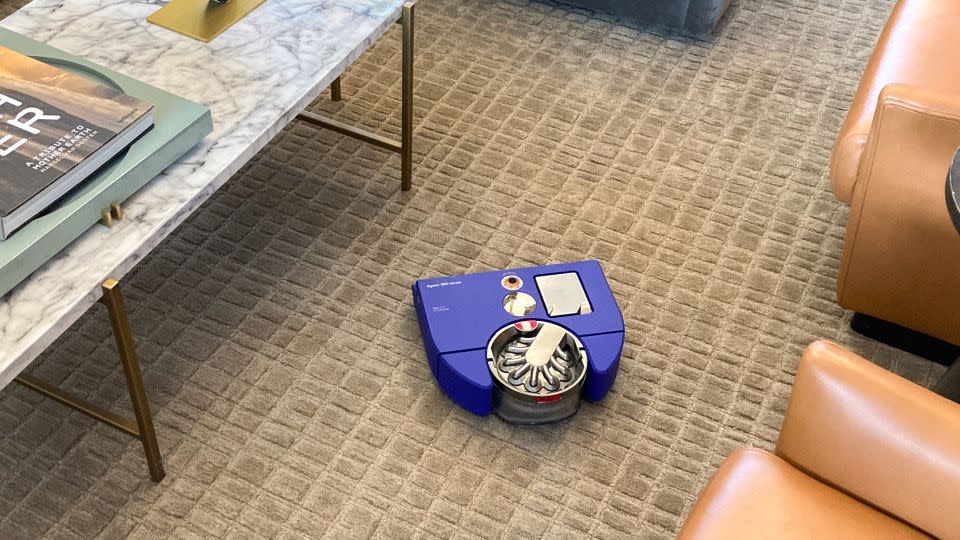
On March 19, Dyson launched the 360 Vis Nav, a highly anticipated robot vacuum from the cult-favorite brand. Robot vac enthusiasts and people who love Dyson’s products have waited a long time for this product — Dyson has only released one other robot vacuum in the U.S., the 360 Eye, in 2016, and it was quickly discontinued after the company decided it was “ill-suited to U.S. homes.” A follow-up robot vac, the 360 Heurist, was released in 2020 but wasn’t available in the U.S. Will the third time be the charm for Dyson’s robot vacuum?
To find out if the Dyson 360 Vis Nav robot vacuum lives up to the hype, we got our hands on one, courtesy of Dyson, and tested it on different types of floors, including hardwood, tile and rugs.
Dyson 360 Vis Nav
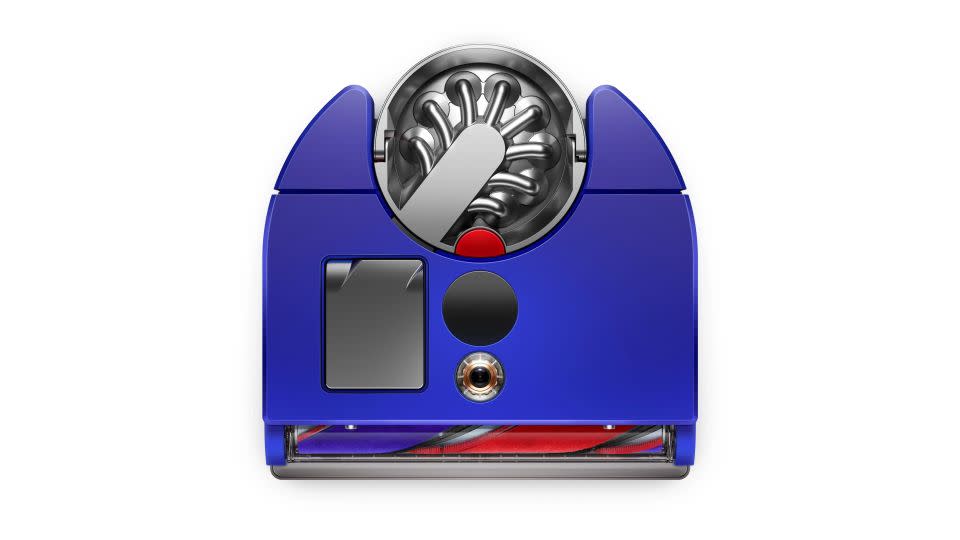
Dyson's second-ever robot vacuum available to the U.S. market, the 360 Vis Nav is an eagerly anticipated new release from the cult-favorite brand. Its suction power and edge cleaning capabilities are impressive, but it lacks features like mopping and self-emptying that we'd expect to see in a robot vacuum at this very premium price. The 360 Vis Nav is already sold out on Dyson's site, but you can still order it from retailers like Amazon and Best Buy.
What we liked about it
Setup was fast and easy
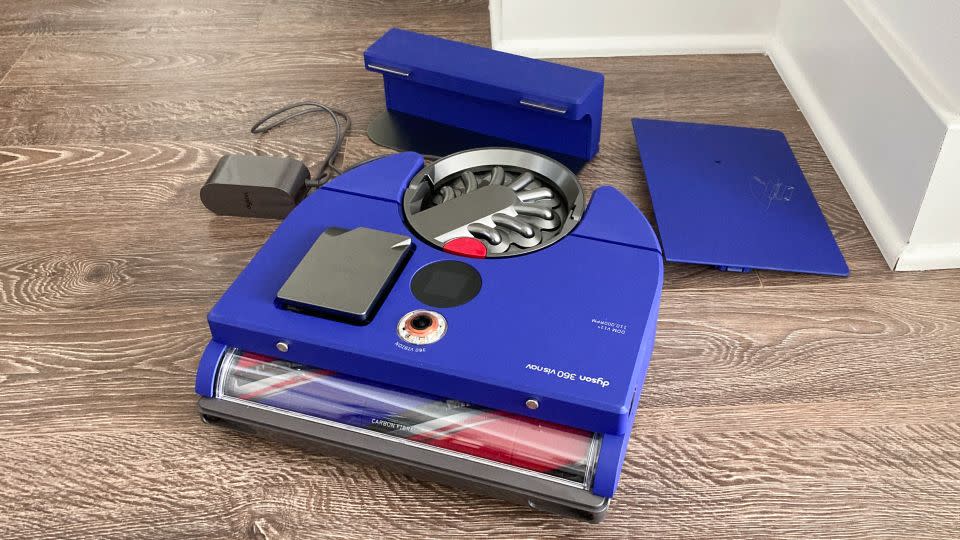
The Dyson 360 Vis Nav has just four parts: The vacuum cleaner itself, a docking base, a docking base panel and a charger. That’s it! Assembly and setup is super easy: Plug the charger into the docking base, snap the panel into the back of the docking base and shove the robot into its home.
After assembling the unit, you will need to connect it to your Wi-Fi and the MyDyson app. The process is straightforward and takes only a few minutes. Once connected, the 360 Vis Nav will perform any necessary updates, displaying a message when those updates are complete. The MyDyson app indicates when the unit is fully charged and ready to clean. I was ready to vacuum within 20 minutes of unboxing the 360 Vis Nav.
You can turn on the robot vacuum three ways: manually, via the app or with voice control. The process of mapping my space and setting up zones was easy, and despite Dyson’s warnings that it could take one to two hours, was finished in about 30 minutes.
I also appreciate that the docking station has a cord wrap that allows you to tuck any excess cord away, leaving it at exactly the length you need. I actually said, “Oh that’s nice!” out loud because it’s an unexpected standout feature. Cord management is a particular nit of mine, so the fact that Dyson built a way to hide the charging cord that connects to the docking station was a feature I immediately noticed. Sometimes it’s just the little things!
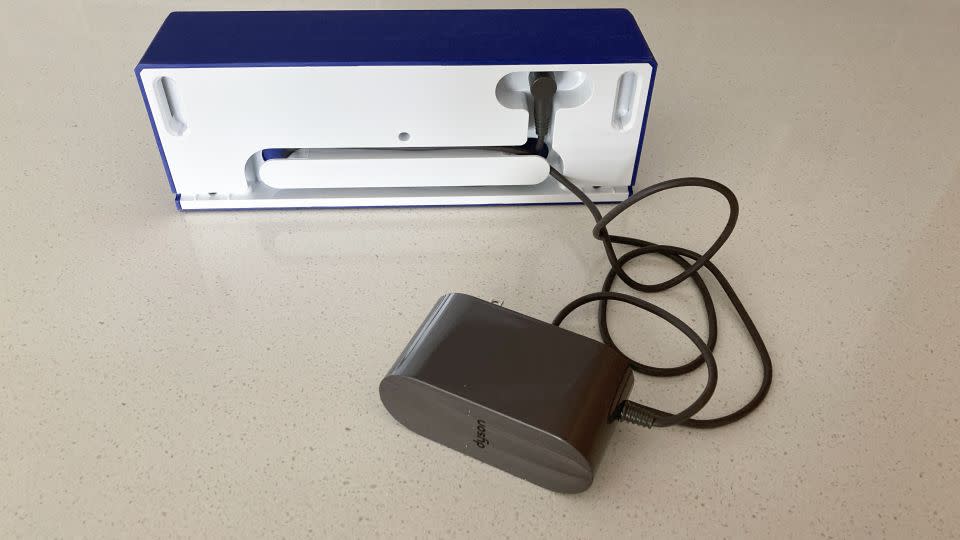
It is excellent on rugs, under furniture and along edges
In our testing, the Dyson 360 Vis Nav performed beautifully on rugs, under furniture and along edges. I have two area rugs in my home, a thin washable shag rug and a polypropylene shag-and-low pile area rug, both of which have been a frustrating chore to vacuum using my trusty Dyson V15s Detect. The V15s Detect eats the edges of the shag rug, and it is a wreck when it comes to the rug in my living room, requiring a lot of effort on my part rather than gliding easily across the fibers. This robot vacuum, however, had no problems whatsoever with either rug. I was unable to perform a test on carpet, but I will update this review after more testing.
The 360 Vis Nav, at 5 inches in height*, is also able to vacuum under furniture with ease — but it did suffer a few scrapes and scratches after vacuuming under the lower kitchen cabinets, which are just shy of 4 inches. However, it was able to free itself when it got stuck, and it cleaned that space well thanks to the machine’s edge cleaner technology, which automatically redirects suction to clean the space right up against the wall. That says a lot considering this area in my home is a hot spot of crumbs, coffee grounds, grains of rice and other detritus from cooking and meal prep. Other robot vacs I’ve tried have fallen short here, so it was a feature I was especially keen on when I started my testing.
*Dyson says the 360 Vis Nav is 3.5 inches tall, but that is misleading because that measurement does not include the height of the wheels.
Incredible suction power for picking up hair, dust, crumbs and more
To test how well the 360 Vis Nav performed at picking up hair and dust, I ran my V15s Detect in the dark after the 360 Vis Nav made its first pass in the bathroom. The V15s Detect has a laser that allows you to see microscopic dust particles that the naked eye doesn’t pick up, and the effect is heightened when used in a dark room.
The results were incredible: With the exception of some hard-to-reach areas that the robot was unable to get to (like the space around the sides and back of the toilet), the 360 Vis Nav robot vacuum picked up every strand of hair and speck of dust in that bathroom. And I have long Rapunzel hair, so there’s no shortage of the stuff to clean up.
Just keep in mind that the suction power will vary depending on which cleaning mode you choose, as will the runtime. Auto mode, which Dyson recommends most people use, has a runtime of 40 minutes. When it needs to be recharged, it will return to its dock and resume cleaning once charged if it had not completed its course before the battery ran low.
Quick mode is recommended for routine, daily cleaning and has a runtime of up to 60 minutes; Quiet mode, which is pretty self-explanatory, will clean for 65 minutes when fully charged; Boost, an intensive cleaning mode that uses the vacuum’s maximum suction power, can clean for just 12 minutes before it needs to recharge.
To test its ability to pick up crumbs, spilled food and other larger-particle substances, I poured a tablespoon each of flour, coffee grounds and basmati rice on my hardwood floor and turned on Boost mode. It handily picked up all three substances, but there were some major performance issues — more on that below.
Smart features include an easy-to-use app and plenty of sensors
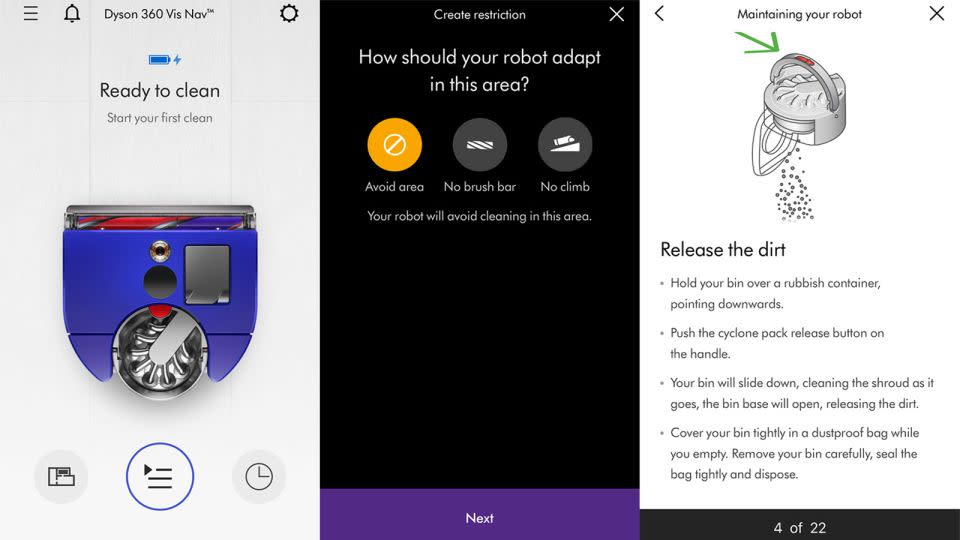
I found the MyDyson app easy to use, and I appreciate that it has both written and video tutorials that cover practically everything you need to know. The app allows you to schedule your vacuum to run on certain days and times, with the option to build different types of cleaning — Auto, Quick, Quiet or Boost — into those schedules.
The app also lets users map their space, creating zones that can be designated for different types of cleaning. You can instruct the robot to avoid certain areas and designate other areas that should not be vacuumed with the brush bar engaged. There’s even a “no climb” option that instructs the vacuum to avoid climbing obstacles in certain areas. The robot’s sturdy wheels are designed to climb things like high thresholds, allowing the vacuum to move easily from room to room; the no climb setting exists so you can designate areas or items, like a cat’s litter box, that you want the 360 Vis Nav to avoid.
The navigation features include 26 sensors, and as you might guess from the name, 360-degree panoramic vision. Among the sensors is an obstacle sensor on the front of the robot that can detect objects for the robot vacuum to avoid, and two pairs of side sensors.
Even with the sensors, you do need to do some tidying up before the 360 Vis Nav can do its cleaning, as is true with all robot vacuums. In my extremely clutter-free home, the 360 Vis Nav successfully navigated around items other robot vacs would have eaten right up, including the drapey corners of my duvet cover and my outdoor sandals that live by the door to the patio.
The 360 Vis Nav is also fitted with a light that is activated when the robot is vacuuming in dark or dimly lit spaces. The light allows the vacuum’s camera-based navigation system to “see” in the dark, which is particularly useful when it comes to hard-to-vacuum spaces like the area under beds.
Emptying the dustbin is a cinch
The Dyson 360 Vis Nav is not a self-emptying robot vacuum, but emptying its bin is incredibly easy. The bin pops out at the push of a button, and it has a handle for carrying it to the trash can. To empty the bin, hold it over a trash can, push a button to open it and release the dirt. That’s it! The release mechanism does create a bit of dust plume, but after a few uses, I was able to sort out the best angle and height to hold the bin to reduce the amount of airborne dust when emptying it.
What we didn’t like about it
The price
Pricing is the bête noire of Dyson fans: The brand’s beloved suite of tools, whether they be for floor care or hair care, are expensive. There’s just no getting around the fact that Dyson’s products, including the 360 Vis Nav, are going to put a major dent in your wallet.
The 360 Vis Nav retails for $1,200. Yep, you read that right. We’re talking about a $1,200 vacuum here. By comparison, our top pick for the best robot vacuum, the iRobot Roomba j7+, has a list price of $800, but at the time of this writing, is available on Amazon for under $600.
However, Dyson is known for iterating — and price reductions usually come along with newer models of existing machines. We expect that to be true of the 360 Vis Nav, and we can also anticipate that older models of its robot vac will hit the market at some point since Dyson does a brisk business selling refurbished vacuums.
At the extremely premium price point, it’s hard to recommend this product when there are lower-priced cleaning robots that can do so much more than the 360 Vis Nav, which doesn’t have any self-emptying, mopping or wet-cleaning capabilities.
Its intelligent navigation system isn’t as intelligent as it claims
During testing, the 360 Vis Nav had several moments of confusion: It got lost on its way back to its dock (other reviewers have noted similar docking station problems); it wouldn’t work without Wi-Fi when we tried to test it in a neighbor’s carpeted apartment; it cleaned in circles and missed spots when we’d expect to see it moving through spaces in straight, overlapping lines; in Boost mode, it did a commendable job of vacuuming up grains of rice, a pile of flour and coffee grounds, but it left an entire half a tablespoon of coffee grounds on the floor during its first pass.
Most egregiously, on its way back to its dock after cleaning in Boost mode, it did manage to pick up that last half tablespoon of coffee grounds, despite the fact that it was not in cleaning mode — but instead of sucking the grounds up, it left a trail back to its dock. Upon examination, it turned out that it also dumped most of the half tablespoon of coffee grounds under and around its dock.
The dustbin is small and needs to be emptied frequently
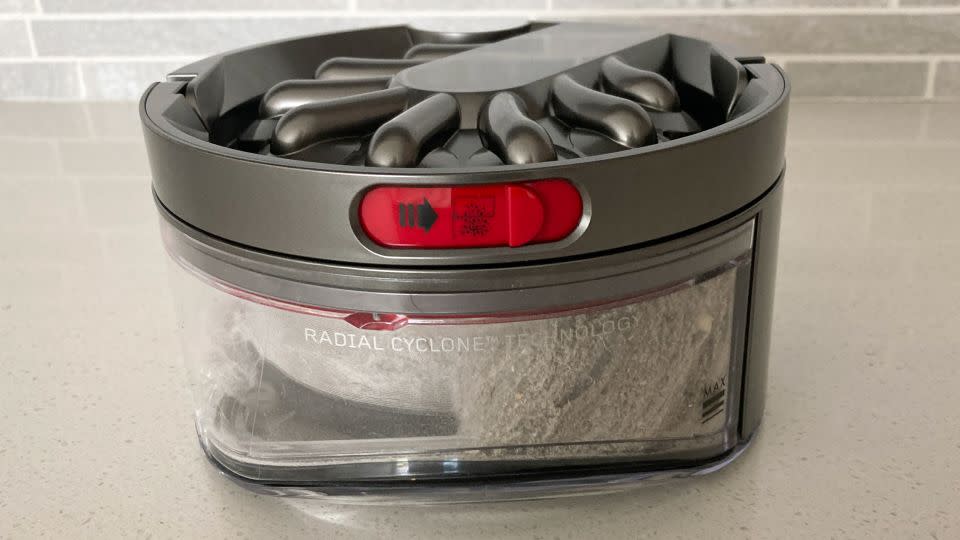
As I previously mentioned, the 360 Vis Nav is not a self-emptying robot vacuum. This is unfortunate because the dustbin, which Dyson says is similar in size to its V8 cordless stick vacuums, struck me as small.
After its first pass through my home, which had been vacuumed two days prior to my testing and is generally pretty clean (occupational hazard), the bin was full and needed to be emptied. In fairness, a significant amount of bin space was taken up by loose fluff from my washable shag rug, which is only about six months old and still in its new rug-shedding stage. I subsequently designated that rug as a no brush bar zone, which I anticipate will cut back on the amount of shag the robot vacuums up.
With that said, I wouldn’t recommend this vacuum for homes with lots of pet hair, unless you’re willing to run and empty it every day.
Quiet mode isn’t especially quiet
Another disappointment is the 360 Vis Nav’s quiet mode which … is just not all that quiet. I don’t have equipment to measure the difference in decibel levels, so to test the quiet mode, I turned the vacuum on at 6 a.m. (sorry neighbors!) while I was in my bedroom and the robot vacuum was in the living room. Let’s just say it was not a whisper-quiet vacuuming experience! I could definitely hear it running, and not in a “what’s that gentle hum coming from the other room?” way.
The charger takes up a lot of outlet space
Compared to the charger for Dyson’s V15s Detect Submarine, the 360 Vis Nav’s charger is bulky. And because it is vertically oriented, it takes up a lot of space in the outlet.
The 360 Vis Nav’s charger is 4 inches long, while the V15s charger is just shy of 3.5 inches. This may not seem like a big difference, but in practice, the size of the larger charger was noticeable and irritating because it took up so much precious outlet space.
The color and name leave a lot to be desired
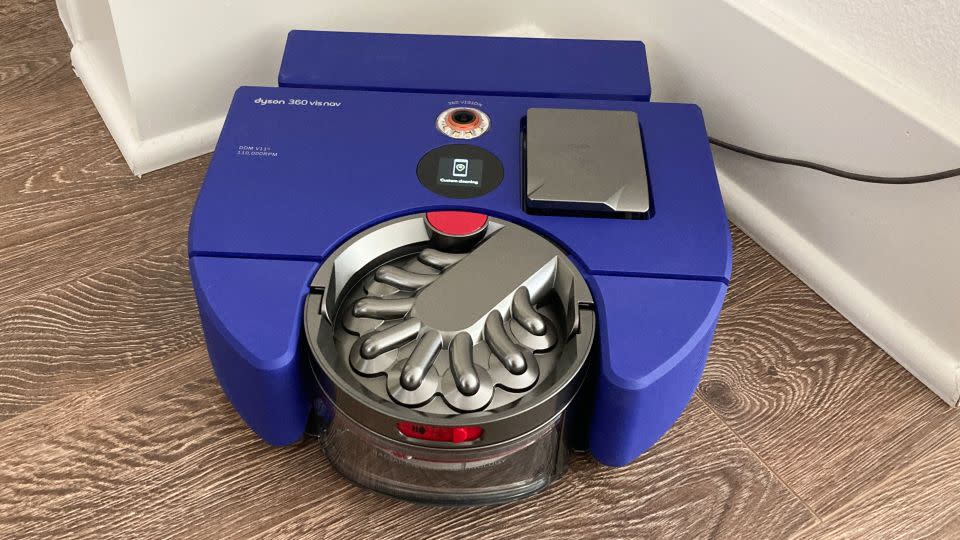
The 360 Vis Nav robot vacuum comes in blurple, one of Dyson’s signature colorways. But that’s the only color option, and it is a very specific shade. Given that robot vacuums live in docking stations and are typically placed in highly trafficked areas (rather than tucked away in a closet), you may find it irritating to be stuck with something so strikingly blue/purple.
However, many people will love its regal good looks. “I want to wrap it in a faux fur coat and have it as a pet!” one friend exclaimed when I showed him a video of 360 Vis Nav gliding around my living room during testing.
This is an exceedingly minor point, but the name 360 Vis Nav lacks the punchiness and quirkiness of other Dyson vacuums. Dyson’s first mop-vacuum combo is called the Submarine. Fun! Its cordless stick vacuums include models called Absolute, Detect, Omni-Glide and Outsize. Kicky! The brand even has a line of upright corded vacuums and cordless stick vacs called Animal! So it’s hard to understand what went wrong in the naming room — did Dyson fire its clever naming people and outsource the work to AI? Unclear.
Bottom line
I entered this review as someone who has not especially been a fan of robot vacuums, and I’m leaving it with a significantly more positive stance on these machines. I would recommend the 360 Vis Nav to Dyson fans who have been waiting for a robot vacuum from the brand.
However, the 360 Vis Nav is not a slam dunk for Dyson. The price is, to put it bluntly, outrageous, especially for a robot vacuum that does not have a self-emptying feature or a mopping function. The intelligent navigation wasn’t exactly the honors student it claims to be, and it made cleaning mistakes — like dragging coffee grounds along the floor on its way back to its docking station — that are unacceptable in any robot vacuum, and which are especially egregious in a Dyson product with such a high price.
As a vacuum, the Dyson 360 Vis Nav is quite good, especially because of its ability to clean edges, as well as its powerful suction that picks up hair, crumbs, dirt and dust with ease. If you love Dyson’s products and are in the market for a robot vac, the 360 Vis Nav is worth considering. But for people simply looking for the best robot vacuum for the money, we think there are better options.
Note: The prices above reflect the retailers' listed price at the time of publication.
For more CNN news and newsletters create an account at CNN.com

